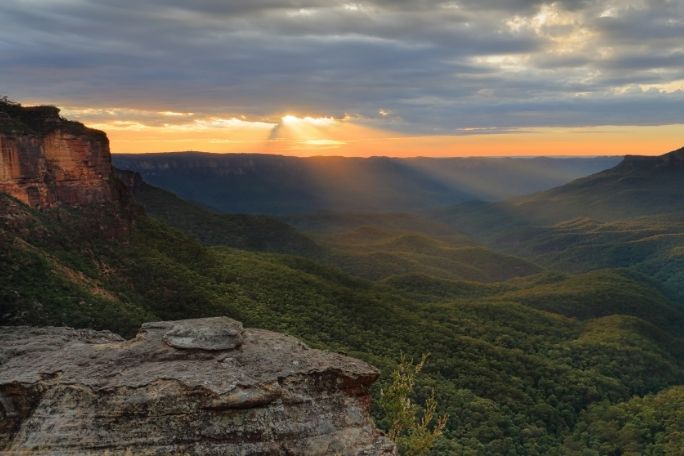Lesson summary
This lesson is based on the film Who We Are: Brave New Clan – Country/Place. Through a range of literacy-based activities, students will explore the relationships some Aboriginal and Torres Strait Islander people have with Country and how with their connection comes a responsibility to care for Country. Students will research how Aboriginal and Torres Strait Islander cultural knowledge is being used to protect Australia’s fragile environment. Students are asked to think about the ways they personally care for their environment and are then asked to create a community service campaign based around the theme ‘We are all caretakers’.
Essential questions:
- How do Aboriginal and Torres Strait Islander peoples understand and care for Country?
- In what ways might Aboriginal and Torres Strait Islander people be caretakers of our environment?
- Why should we all be caretakers of our environment?
- How can we all look after our environment?
Lesson guides and printables
Curriculum links
Select your curriculum from the options below.
Lesson details
Curriculum mapping
The films and lessons presented in Who We Are: Brave New Clan have been designed to align with the organising ideas of the Australian Curriculum’s cross-curriculum priority of Aboriginal and Torres Strait Islander Histories and Cultures. Use of the film in a classroom setting will build teachers’ and students’ knowledge of, understanding and respect for Aboriginal and Torres Strait Islander histories, cultures, contributions and ways of life.
Australian curriculum content descriptions:
Year 4 HASS:
- The diversity of Australia’s first peoples and the long and continuous connection of Aboriginal and Torres Strait Islander Peoples to Country/Place (land, sea, waterways and skies) (ACHASSK083)
- The custodial responsibility Aboriginal and Torres Strait Islander Peoples have for Country/Place, and how this influences views about sustainability (ACHASSK089)
Year 4 English:
- Plan, draft and publish imaginative, informative and persuasive texts containing key information and supporting details for a widening range of audiences, demonstrating increasing control over text structures and language features (ACELY1694)
Year 5 English:
- Plan, draft and publish imaginative, informative and persuasive print and multimodal texts, choosing text structures, language features, images and sound appropriate to purpose and audience (ACELY1704)
Year 6 English:
- Plan, draft and publish imaginative, informative and persuasive texts, choosing and experimenting with text structures, language features, images and digital resources appropriate to purpose and audience (ACELY1714)
Syllabus outcomes: GE2-2, GE2-3, EN2-2A, EN3-2A.
Relevant parts of Year 4 HASS achievement standards: Students identify the interconnections between components of the environment and between people and the environment, and describe factors that shape a person’s identity and sense of belonging.
Relevant parts of Year 4 English achievement standards: Students create texts that show understanding of how images and detail can be used to extend key ideas, and actively contribute to class and group discussions.
Relevant parts of Year 5 English achievement standards: Students create imaginative, informative and persuasive texts for different purposes and audiences, and contribute actively to class and group discussions, taking into account other perspectives.
Relevant parts of Year 6 English achievement standards: Students create detailed texts elaborating on key ideas for a range of purposes and audiences, and contribute actively to class and group discussions.
Cross-curriculum priority:
Aboriginal and Torres Strait Islander Histories and Cultures OI.2 – Aboriginal and Torres Strait Islander communities maintain a special connection to and responsibility for Country/Place.
General capabilities: Intercultural Understanding, Ethical Understanding, Critical and Creative Thinking, Literacy.
Unit of work: Who We Are: Brave New Clan – Country/Place.
Time required: 60 mins.
Level of teacher scaffolding: Medium – oversee discussion, lead students in activities.
Resources required
- Student Worksheet – one copy per student OR computers/tablets to access the online worksheet
- Device capable of presenting a website to the class
- Device for creating audio or video recordings such as a tablet or camera
- Drawing materials
Skills
This lesson is designed to build students’ competencies in the following skills:
- Critical thinking
- Collaboration
- Creativity
- Communication
- Empathy
- Cultural understanding
- Ethical understanding
- Problem solving
- Global citizenship
Additional info
This lesson is produced in partnership with Cool Australia and the Narragunnawali: Reconciliation in Education team at Reconciliation Australia.
We acknowledge and pay respect to the past, present and future Traditional Owners, Custodians and Elders of this nation and the continuation of cultural, spiritual and educational practices of Aboriginal and Torres Strait Islander peoples.
We respectfully caution Aboriginal and Torres Strait Islander peoples that this resource may contain images and names of people who have passed away.We respectfully caution Aboriginal and Torres Strait Islander peoples that this resource may contain images and names of people who have passed away.


Welcome back!
Don't have an account yet?
Log in with:
Create your free Cool.org account.
Many of our resources are free, with an option to upgrade to Cool+ for premium content.
Already have an account?
Sign up with:
By signing up you accept Cool.org's Terms and Conditions(Opens in new tab) and Privacy Policy(Opens in new tab).